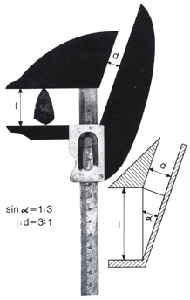|
For assessing the grain shape of broken
stone, stone chippings (including oversize aggregate and undersize aggregate)
and round-sufaced gravel grain
The average sample - with grain
sizes of 8-12mm, approx. 5 kg; with grain sizes of 12-35 mm, approx. 15 kg; with
grain sizes of more than 35 mm, approx. 30 kg - is dried, thoroughly mixed and
spread out circularly on a flat surface. The spread-out sample is then divided
with a flat straight edge longitudinally and transversely so that four
right-angled sectors are formed of the circular area. Of these sectors, two
opposite ones are again mixed and then spread out as before. Dividing into four
sectors is repeated until the residue consists of about 250-300 grains only.
Form this residue, the grains of less than 8 mm are screened off.
Using the grain-shape vernier
calliper (see
illustation)

|
For every
setting, the length I is equal to three times the thic
-kness d. Each of the
250-300 grains is held between the right-angled measuring jaws of the grain
vernier calliper. In doing so, the vernier calliper is adjusted to the maximum
length*of each grain. The inclined measuring slot for the thick - ness adjusts
itself simultaneously to 1/3 of the length. lf the grain does not pass through
the inclined slot in this setting, then it is called ≪squat≫ (favourably
shaped); if it passes through, then it is ≪badly shaped≫(flatish or spiky), i,
e. the ratio of length to thickness is then greater than 3:1. The quantity of
the ≪squat≫ and the ≪badly shaped≫ grains is weighed. As a result, the share of
≪badly shaped≫grains is given percentage of weight of the test sample. The
smaller this share is, the better the average quality of the grain shape will
be.
|
*) In the assessment of
grain shape described up to now in DIN 51991, the ≪lenght≫ of the grain is
defined as being the edge of the smallest priam circumscribed round the grain.
In the vernier calliper method, on, the other hand, the ≪length≫ of the grain is
the largest dimension of the grain it has in any direction (e. g. diagonally).
The grain must therefore be rotated between the right-angled jaws until the
largest dimension of the grain has been
set. |

